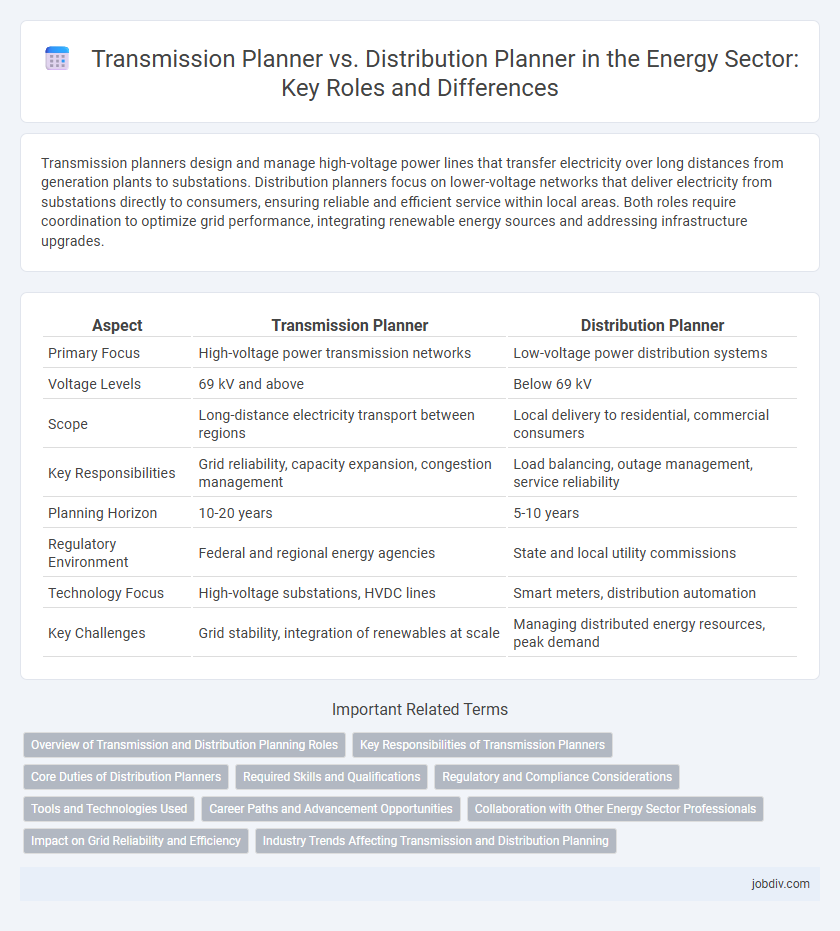Transmission planners design and manage high-voltage power lines that transfer electricity over long distances from generation plants to substations. Distribution planners focus on lower-voltage networks that deliver electricity from substations directly to consumers, ensuring reliable and efficient service within local areas. Both roles require coordination to optimize grid performance, integrating renewable energy sources and addressing infrastructure upgrades.
Table of Comparison
| Aspect | Transmission Planner | Distribution Planner |
|---|---|---|
| Primary Focus | High-voltage power transmission networks | Low-voltage power distribution systems |
| Voltage Levels | 69 kV and above | Below 69 kV |
| Scope | Long-distance electricity transport between regions | Local delivery to residential, commercial consumers |
| Key Responsibilities | Grid reliability, capacity expansion, congestion management | Load balancing, outage management, service reliability |
| Planning Horizon | 10-20 years | 5-10 years |
| Regulatory Environment | Federal and regional energy agencies | State and local utility commissions |
| Technology Focus | High-voltage substations, HVDC lines | Smart meters, distribution automation |
| Key Challenges | Grid stability, integration of renewables at scale | Managing distributed energy resources, peak demand |
Overview of Transmission and Distribution Planning Roles
Transmission planners focus on designing and optimizing high-voltage networks that deliver bulk power across long distances, ensuring grid reliability and managing system contingencies. Distribution planners oversee the lower-voltage network that delivers electricity directly to end consumers, focusing on local load growth, voltage regulation, and integration of distributed energy resources. Both roles require detailed system modeling, load forecasting, and coordination with grid operators to maintain efficient and resilient power delivery.
Key Responsibilities of Transmission Planners
Transmission Planners are responsible for designing and maintaining the high-voltage grid infrastructure that ensures efficient bulk power transfer across long distances. They conduct load flow analysis, system reliability assessments, and contingency planning to prevent outages and accommodate future demand growth. Their role includes coordinating with generation planners and regulatory bodies to optimize transmission expansion and integration of renewable energy sources.
Core Duties of Distribution Planners
Distribution planners primarily focus on designing and optimizing the power distribution network to ensure reliable delivery of electricity from substations to end consumers. Their core duties include load forecasting, identifying system upgrades, managing distributed energy resources integration, and ensuring compliance with safety and regulatory standards. These planners analyze feeder capacity, voltage levels, and outage impacts to maintain system reliability and efficiency at the distribution level.
Required Skills and Qualifications
Transmission planners require advanced expertise in power system analysis, grid stability, and high-voltage transmission infrastructure, often holding degrees in electrical engineering with certifications in grid management. Distribution planners focus on skills related to low-voltage networks, smart grid technology, and customer demand forecasting, typically requiring knowledge of distribution automation and geographic information systems (GIS). Both roles demand proficiency in software tools like SCADA and power flow modeling, alongside strong analytical and project management abilities.
Regulatory and Compliance Considerations
Transmission planners must ensure compliance with national grid codes and federal regulations mandated by agencies such as FERC, focusing on long-distance high-voltage power flow reliability and interconnection standards. Distribution planners navigate local utility regulations and state public utility commissions' requirements, emphasizing safety standards, voltage regulation, and customer-driven distributed energy resources integration. Both roles require adherence to environmental laws and coordinated documentation to support regulatory audits and infrastructure approval processes.
Tools and Technologies Used
Transmission planners utilize advanced Geographic Information Systems (GIS), load flow analysis software, and Phasor Measurement Units (PMUs) to design and optimize high-voltage power networks, ensuring grid stability and efficient long-distance electricity flow. Distribution planners rely on Distribution Management Systems (DMS), outage management technologies, and smart grid solutions like advanced metering infrastructure (AMI) to manage lower voltage networks, enhance reliability, and integrate distributed energy resources. Both roles incorporate simulation tools and data analytics, but transmission focuses on large-scale system performance, while distribution emphasizes localized operational efficiency.
Career Paths and Advancement Opportunities
Transmission planners specialize in large-scale grid infrastructure, ensuring high-voltage power flow efficiency and reliability, with career advancement often leading to senior engineering or grid management roles. Distribution planners focus on low-voltage networks, optimizing local energy delivery and integrating distributed energy resources, typically progressing toward positions in smart grid development or utility operations management. Both career paths offer opportunities for specialization in renewable energy integration, regulatory compliance, and advanced grid technologies, enhancing prospects for leadership and strategic planning roles within the energy sector.
Collaboration with Other Energy Sector Professionals
Transmission planners collaborate closely with generation engineers, system operators, and regulatory bodies to ensure grid reliability and efficient long-distance power delivery. Distribution planners work alongside local utilities, demand response specialists, and renewable energy developers to optimize distribution networks for end-users. Their coordinated efforts enable seamless integration of transmission and distribution systems, enhancing overall grid resilience and operational efficiency.
Impact on Grid Reliability and Efficiency
Transmission planners focus on high-voltage network design, enhancing grid reliability by preventing large-scale outages through strategic infrastructure investments and long-term capacity forecasting. Distribution planners optimize low-voltage systems to improve localized efficiency, ensuring stable power delivery and minimizing losses in end-user areas. Both roles are critical for maintaining an integrated, resilient grid that balances broad-scale transmission capacity with efficient, reliable distribution.
Industry Trends Affecting Transmission and Distribution Planning
Transmission planners increasingly integrate advanced grid technologies and renewable energy sources to enhance long-distance power flow reliability, responding to regulatory mandates and decarbonization targets. Distribution planners focus on optimizing local grid resilience and accommodating distributed energy resources (DERs), such as solar PV and energy storage, driven by rising consumer demand for sustainable energy solutions. Industry trends highlight the growing convergence of transmission and distribution systems, leveraging smart grid analytics and predictive modeling to improve overall grid efficiency and stability.
Transmission Planner vs Distribution Planner Infographic

 jobdiv.com
jobdiv.com